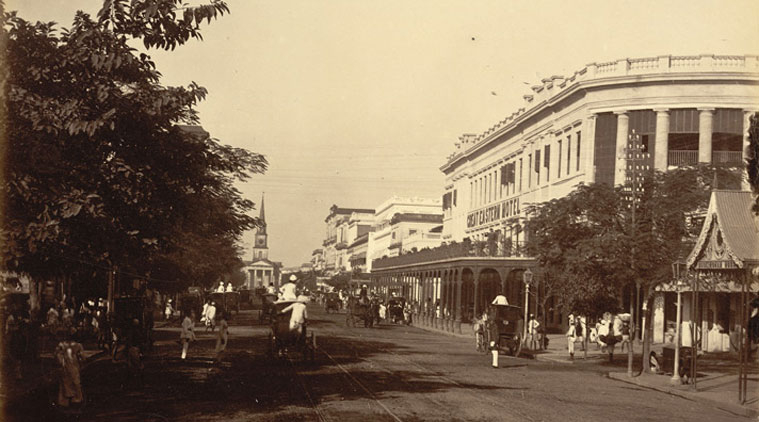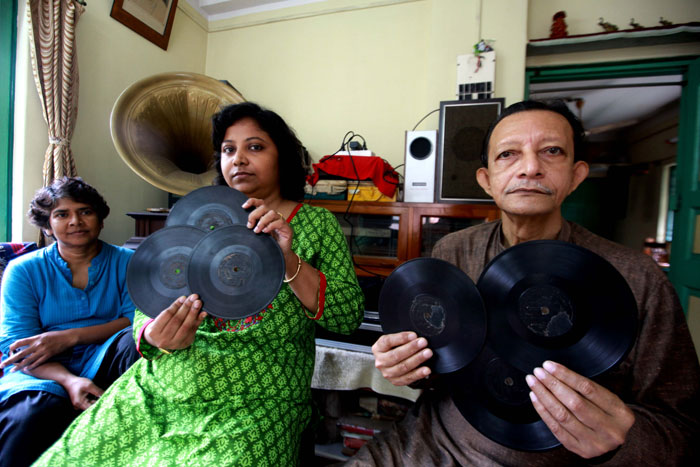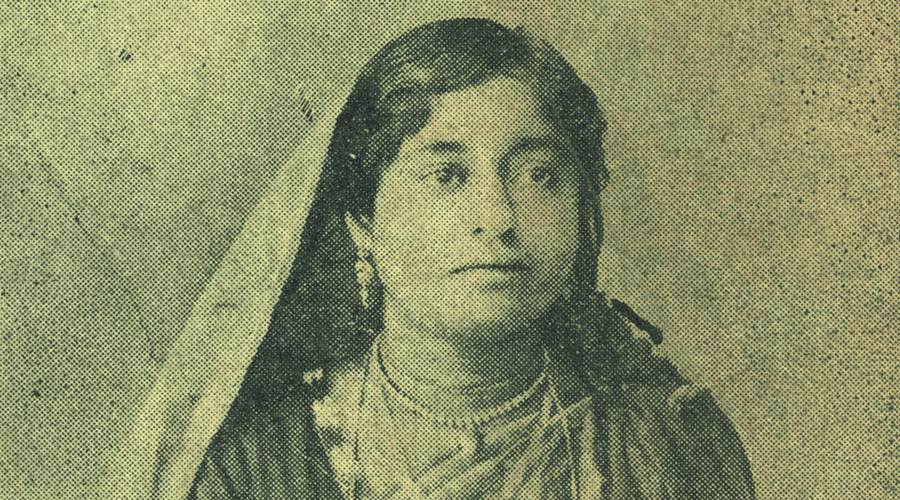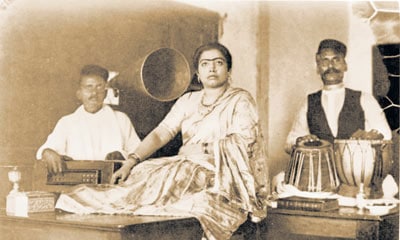Sandpaper rubbing against wood — that’s the sound that crackles out of the speaker of an old gramophone player. A 7” shellac record is spinning on a rare day out of its leather case; a few seconds later, a faint tune can be heard. A nasal voice sings a plaintive tune, a few Bengali words can be made out: ami (me), sajani (beloved), kushumeri (flower). On the day she sang the song, Sashimukhi was a 14-year-old unlettered girl from Calcutta’s Chitpur district, and she’d never seen a recording device before. It was Saturday, November 8, 1902 and little could she have known that hers would be the first voice to be recorded on a gramophone in India.
At any rate, neither she nor her friend Phanibala were able to impress Frederick William Gaisberg much. “Two little nautch (dancing) girls aged 14 and 16 with miserable voices,” observed the American-born musician, recording engineer and one of the earliest classical music producers for the gramophone in his diary.
Gaisberg had set up a makeshift studio in a room at the illustrious Great Eastern Hotel, and how he found himself there is a story that reflects the history of the women who were a part of Calcutta’s entertainment industry in the early 20th century.
In his book, The Gramophone Company’s First Indian Recordings, 1899-1908, Australian academic and researcher Michael S Kinnear tells us about how, in 1901, the Gramophone and Typewriter Ltd in London sent a certain John Watson Hawd to Calcutta to investigate the prospects of the “talking machine” or the gramophone in India. Hawd toured the country, visiting Bombay, Delhi and Madras, before writing to the head office to recommend the opening of a branch in Calcutta. He also suggested that recording experts be sent to India to make “native” recordings — a promising business waiting to be tapped into. The records would be pressed in Germany and sold in India.
With its indigenous theatre forms like jatra and pala, Calcutta was ripe for such an initiative. Hawd scouted locations in the city for the recordings and made arrangements with two theatre owners, Jamshedi Framji Madan of Corinthian Theatre and Amarendra Nath Dutta of Classic Theatre, to supply artistes. Sashimukhi and Phanibala were members of Classic Theatre and were ushered into Gaisberg’s hotel room in central Calcutta one day, their faces obscured in long veils.
At first sight, Gaisberg’s recording equipment would have been rather intimidating. “A brass/metal horn was used as the microphone for recording, and they would place a wax-coated disc on the turntable and rotate it at 78 rpm. Artistes would bring their mouths close to the recording horn and sing. The voice would then pass through the narrow neck of the horn and to the needle rotating in the wax coating. This would cut the grooves in the plane wax surface,” says Suresh Chandvankar, honorary secretary of the Society of Indian Record Collectors, and an employee at the Tata Institute of Fundamental Research, Mumbai.
Today, 113 years later, there is not a single trace of that afternoon at The Great Eastern Hotel. The recently-renovated property retains its heritage wing, replete with wood-panelled walls, crystal chandeliers and wrought-iron staircases, but the names Sashimukhi and Gaisberg ring no bells. It’s in a much humbler setting that they find a suitable resonance.

On a rain-drenched afternoon in suburban Kolkata, Sashimukhi sings to us from a recording of a recording. The small room feels cramped with glass-fronted cupboards along the walls. Each corner has a gramophone player, each more stately than the other. Panchu Gopal Biswas, 68, a private collector of gramophone records has lived in this building in the northern fringes of the city for more than 50 years. “This entire floor is meant for my collection,” says Biswas. A tall man with a toothy smile, he doesn’t quite fit the bill of the eccentric hoarder — except for the fact that he has been buying records compulsively since he passed out of school in the mid-1960s. Today, he boasts of a collection of more than 20,000 records and has been in possession of what appears to be the only surviving copy of the rare Sashimukhi record for the past 40 years.
“It is full of scratches,” says Biswas. The label on it has all but disappeared, an engraving on it reveals its serial number, 13024. A faint engraving in the middle says “Sashi-muki” and then the name of the song, Ami ki sajani kushumeri (Is My Beloved a Flower…) in Bengali. “It’s in a very fragile condition, each time we play it, it loses a large chunk of its lifespan,” says Indrani Majumdar, 37, a researcher and sound archivist associated with Phonogramm Archive, Berlin, who tracked Biswas down to “listen to Sashimukhi” two years ago.“I would not have preserved the record as carefully as I have had I not read about its significance in a small write-up about Kinnear’s book on Indian gramophone records about 15 years ago,” says Biswas, who used to work with Kolkata Municipal Corporation before retiring in 2012. “When I started buying records, I would spend Rs 4 a month on them,” says Biswas. Today, he spends about Rs 4,000 a month — a large chunk of his monthly pension — buying new material and maintaining his collection. “I don’t have much else to spend on. I never married and don’t have dependents,” he says.
 Sound archivist Indrani Majumdar (left) tracked down Panchu Gopal Biswas in Kolkata to listen to Sashimukhi’s song
Sound archivist Indrani Majumdar (left) tracked down Panchu Gopal Biswas in Kolkata to listen to Sashimukhi’s song
Biswas’s deep love for music developed from an unfulfilled dream, he wanted to be a classically trained singer himself. “I did go to music school for sometime, but never got to sing professionally. You can’t do that when you have a full-time job,” says Biswas, who also has rare records of Gauhar Jaan, Mrinalini Dasi, Angur Bala Devi and Indubala Devi in his collection. He supposes that he bought the record in the early 1970s from a shop in Free School Street in central Kolkata.“But I didn’t know who Sashimukhi was,” says Biswas.
So who was Sashimukhi? Doesn’t the distinction of the first Indian voice to be recorded belong to the formidable Gauhar Jaan? In his book, Kinnear writes: “As a consequence of attending a dinner party of a wealthy Bengali gentleman a few days earlier, Fred Gaisberg had arranged to take recordings on Tuesday 11th November, of Miss Gauhar Jan, an artist of considerable repute. She was to become a primary objective for future recording expeditions and many of her recordings were amongst the best-selling records in India for many years.”
Gaisberg, who had arrived in Calcutta a few days before the scheduled recordings were to take place, also set forth in search of other artistes. “He was mostly disappointed with the rustic way of singing. He wasn’t impressed with the male singers either,” says Majumdar. Most of the early recordings were taken from nautch girls, baijis and kothewalis (courtesans).
 Sashimukhi
Sashimukhi
Sashimukhi, too, was a nautch girl from Chitpur. In his diary, later published as The Fred Gaisberg Diaries, the archivist wrote: “All the female singers were, of course, from the caste of the public women, and in those days it was practically impossible to record the voice of a respectable woman. The songs and dances were passed by word of mouth from mother to daughter. They began public appearances at the age of 10 to 12 years. The clever ones went up to the top and sometimes travelled all over the country in great demand at the wedding feasts of the wealthy. As they began to make names for themselves many of them insisted that the word ‘amateur’ should be printed on record label. Fees as a rule were very reasonable in comparison to those paid in Europe.”
But the expenses, nominal as they were, would add up. Gaisberg noted that most of the artistes had to undergo long periods of training before they recognised as acceptable gramophone singers. “Sashimukhi was a child prodigy, a stage artist in local theatrical groups such as the Corinthian, Star, Minerva. Her colleague on stage was Phanibala and they were probably the youngest female singers of that time. A majority of the nautch girls of the time worked in the streets or mohallas, some entertained the common public, while some others acted on stage and in silent films. In the case of baijis and kothewalis, most of them lived miserable lives but some of them were very famous, like Gauhar Jaan, who had the patronage of the elite. Gaisberg could not distinguish between Jaan and someone like Sashimukhi. Hence, he used a generic term — ‘nautch girl’ — even for some of Gauhar Jaan’s early record labels,” says Chanvankar.
Daminee Basu, 33, completed her PhD in cultural anthropology at the Centre for Studies in Social Sciences, Kolkata in 2011 and says that a strict hierarchy was maintained among Indian women in “public life”. “The lowest rung was that of khanaki, who was mainly engaged in sex work. Then, there was the kaneez, who was involved in serving people and doing menial jobs. Then came the baiji, who would entertain clients by singing and dancing. After them, of course, was the Jaan, the highest level. Not everybody could be a Jaan. That honour was earned by the virtue of talent, looks and dedication. Artists like Gauhar had relatively more financially independent lives than most other women of her ilk,” she says. While it is difficult to determine which class Sashimukhi belonged to, Basu estimates that a performer like her was most likely a baiji. “Very little research has been done on public performers like her,” she says.
 A record by Gauhar Jaan’s mother Malka Jaan
A record by Gauhar Jaan’s mother Malka Jaan
According to Sushil Kumar Mukherjee’s book, The Story of Calcutta Theatres, Sashimukhi made her theatre debut in 1916; till then, she had been occupied with honing her singing skills. “She eventually went on to make quite a name for herself onstage. Those days, theatre performers had to be good singers and dancers and Sashimukhi was equally adept at both,” says Majumdar.
Sashimukhi, it appears, was a rising star of the vibrant Bengali theatre scene in the early 20th century. Those were the golden years of the form, patronised by the likes of Girish Chandra Ghosh — “the Father of Bengali theatre” — a poet, playwright, musician who mentored Binodini Dasi, one of the most successful performers of the time. In his book, Rangaloye Banganoti, Amit Mitra points out that in the 1919 play Paradesi, Sashimukhi enthralled the audience with her performance as a Muslim character named Saniya. She was at her seductive best in Hindu Beer, where she played Duliya, an assertive young woman who knows her mind and has to pay for it. In the later years, Sashimukhi made her name as the tragedy queen of the Bengal stage. “People refused to see her in tragedies though she would often choose to play tragic figures. Her audience didn’t like the idea of her suffering so much,” observes Mitra.
Little is known about Sashimukhi’s life after her career ended and she died in 1937. All that is left of her is her voice captured in the grooves of a record. Majumdar and Biswas are keen to digitise the recording before it becomes permanently damaged from age. “We can’t afford to lose this precious piece of history. But India doesn’t have the technology to digitise something this fragile in a proper, scientific manner. We need to take it to either Germany or the USA where they can use laser techniques. But for that we need funds and we have been unsuccessful in procuring them so far,” says Majumdar.
What’s that sound? A brief history of the gramophone
1877 — Thomas Alva Edison discovers a way to record and reproduce sound. Recordings were taken on wax-coated cylinders.
1888 – German emigrant in America, Emilie Berliner invented flat disc format for sound recording. The first trial disc was made of rubber with a 5” diameter. 7” diameter zinc and lac records were manufactured and called the E Berliner Records.
1898 – The Gramophone and Typewriter Co in London is founded. Arrangements are made to manufacture gramophones, records and assembly of machines in Germany.
1899 — Recording of first Indian artists in London, Dr Harnamdas and Mr Ahmad, of songs from the Ramayan and Aayats from the Quran.
1902 — First recording expedition of Fred W Gaisberg in Calcutta. Gauhar Jaan and other artistes record their songs.
1902-1908 — Three recording expeditions to India, resulting in nearly 5,000 recordings.
1915/16 — Nipper, the Gramophone Dog, makes first appearance on Indian record label.
1930/31 — Bombay radio became operational, and sound is introduced in Indian films.












